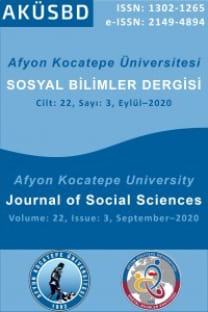Romanya Muhasebe Sistemine Tarihsel Bir Bakış
A Historical Overview of Accounting in Romania
___
- CALU, D. (2005). lstorie si dezvoltare privind contabilite din Romania. Bucharest, Romania: Ed. Economica.
- DEMETRESCU, C.G. (1947). lstoria critica literaturii contabile din Romania. Bucharest, Romania: Ed. Socec Co.
- DEMETRESCU, C.G. (1972). Istoria contabilitatti. Bucharest, Romania: Ed. Stiintifca.
- EICHENGREEN, B. (1995). Europe 's post-war recovery. Cambridge, U.K.: Cambridge University Press.
- EUROPEAN CENTRAL BANK. (2006). Assessment of accounting standards from financial stability perspective. Retrieved from http://WWW.ecb.int/pub/pdf/other/assessmentaccountingstandards2006en.pdf
- EUROPEAN COMMISSION. (2012). Romania. Retrieved from http://ec.europa.eu/enterprise/policies/sme/businessenvironment/fıles/annexes_accounting_report_20 1/romania_en.pdf
- FELEAGA, N. (1999). Sisteme contabile comparate. Bucharest, Romania: Ed. Economica.
- GUZEL, H.C., Oguz, C., Karatay, O., Ocak, M. (2002). The Turks: Ottomans. Istanbul, Turkey: Yeni Turkiye.
- HENTEA, C. (2007). Brief Romanian military history. New York, NY: Scarecrow Press.
- KELLOGG, F. (1995). The road to Romanian independence. West Lafayette, IN: Purdue University Press.
- RADU, R. (1995). raditii si impliniri in cultura economica si contabila romaneasca in sec. al XIX-lea si al XX-lea. Iasi, Romania: Ed. Junimea.
- RATLIFF, W.G. (1991). Treaty of San Stefano. In J.S. Olson R. Shadle (Eds), Historical dictionary of European imperialism (pp. 625-626). Westport, CT: Greenwood Publishing Group
- ROPER, S.D. (2013). Romania: The unfinished revolution. New York, NY: Routledge.
- TSAMENYI, M. Uddin, S. (2009). Accounting in emerging economies. New York, NY: Emerald.
- VINALS, J. (2010). Romania: Financial sector stability assessment. Washington, D.C.: International Monetary Fund.
- ISSN: 1302-1265
- Yayın Aralığı: 4
- Başlangıç: 1999
- Yayıncı: Afyon Kocatepe Üniversitesi Sosyal Bilimler Enstitüsü
To the Lighthouse ve Mrs. Dalloway’de Kadın
Okul Öncesi Öğretmenlerinin Müzik Etkinliklerinde Yaşadığı Sorunlar
mümtaz levent AKKOL, vuslat OĞUZ, güneş SALI
Kurumsal Yönetim Endeksinde Yer Almanın Mevduat Bankalarının Performansına Etkisi: BİST Orneğil
Motlern Algı Teorisinin Teolojik Kökenleri: Ozgür İrade ve Determinizm Problemi
Uygur Şairi Muhemmetcan Raşidin ve Şiir Dünyası
Konservatuvar Eğitimine Sosyolojik Bir Bakış
Yeni Anayasadan Yerel Beklentiler: Ağrı’da Bir Saha Araştırması
